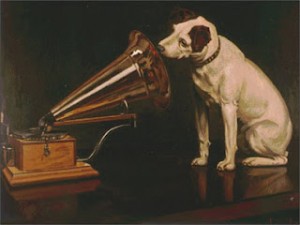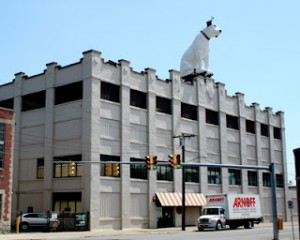When the Arnoff family purchased this building in 1997, the Albany community was very concerned about the future of their beloved Nipper, fearing that he might be dismantled by the new owners. Local politicians, community members, and reporters demanded answers to their questions about Nipper’s fate, and Arnoff Moving & Storage responded by not only completely renovating the building, but by restoring Nipper, as well, to his previous glory. This delighted the Albany community and all those who love him from around the world. Testimony to this is on the front page of the Albany Times Union newspaper, which featured the top bold headline about how Nipper has been saved, and below it, beneath the fold, the headline that Mother Theresa had died.
The history of 991 Broadway, according to Duncan E. Hay of the Northeast Museum Services Center, begins circa 1912: “This reinforced-concrete building was constructed around 1912 to house the manufacturing operations of the American Gas Meter Company. In 1958 it became the home of RTA, distributors of RCA electrical appliances. About that time a twenty-five-foot, four-ton statue of Nipper, the symbol of the Victor Company, was erected on the roof. The statue was built by the W. L. Stansgaard Company of Chicago, shipped on railroad flat cars in five sections, and erected by James McKinney and Company using a ten-story crane.”
The story of Nipper began in 1884 in Bristol, England, where the little stray mutt (part bull terrier, part fox terrier) found a home with Mark Barraud, a Bristol theater stage set painter. The dog was named Nipper because he always nipped at people’s ankles. When Mark Barraud died, his brother Francis adopted the dog, but Nipper seemed to miss his original master and would sit in his habitual pose, listening to the phonograph with his head cocked, seemingly waiting for his master’s voice. Although Nipper died in 1895, four years later, Francis Barraud, a painter, captured the scene on canvas. Then, in an effort to brighten the painting, which he felt was too dark, he borrowed a brass horn from the Gramophone Company in London to paint over the original phonograph. They offered to purchase the painting if Francis would paint their new disc gramophone into the painting, which is how the final image of “His Master’s Voice” came to being. In 1900, the painting became the trademark for Victor Talking Machine, later known as RCA Victor, and the rest is history, as Nipper became one of the most recognized trademarks in the world.
Tags
Subscribe to Arnoff Moving & Storage's Blog
s









Comments